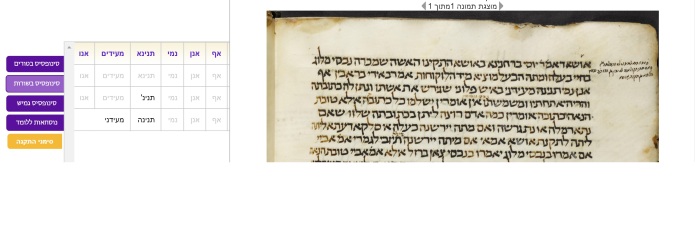
A screenshot from Hachi Garsinan 2.0: a synopsis of b. Bab. Kam. 89a (left) and a genizah fragment from Oxford, Heb.c.21/31-36, with a marginal note in Judaeao-Arabic
Since its creation, the text of the Talmud has been the object of critical inquiry. Amoraim inquired after the exact wording of Tannaitic texts, Geonim struggled to establish the correct version of the Oral Talmud, as did the Rishonim with their written copies. The advent of philology, from the renaissance on, prompted the collection and collation of manuscript copies of the Talmud as well as scholarly emendations and corrections. The Vilna Shas is the product of many centuries of scholarly work, pious and less-so, presented to the discerning student in what was the best technology available.
Attempts at creating a “critical edition” of the Bavli have, however, floundered, though not for lack of trying. Off the cuff I counted eight different attempts at an edition which would establish a text and present variants, but none of them have managed to become the new standard in the field. They are indispensable tools for study – but they have never supplanted the printed edition.
The newest product of the Friedberg Geniza Project, a website known as Hachi Garsinan, held an event on 30 May at which they promised that within two or three years they would have, for the perusal of the learned public, an “online edition” of the Babylonian Talmud according to all its variants and textual witnesses. Prof. Yaakov Choueka and Drs. Menahem Katz and Ronnie Shweka (the son of Prof. Choueka), of Genazim, presented the product. Katz is the project’s advisor for Talmudic research; Dr. Shweka is billed only as “R&D and algorithms,” but he is an accomplished scholar of rabbinics and geonica as well. The project was supervised by a team of old-fashioned textual scholars, who made sure it would serve the scholarly community well.
For Prof. Choueka this is an important milestone in the coming of age of yet another brainchild combining Jewish textual scholarship and the forefront of computer science. Shweka is one of the developers of the Bar-Ilan Responsa project, and all of us owe him a huge debt of gratitude for his work on the linguistic and morphological algorithms which we use each day. Information technology has certainly come a long way from the days when the responsa project lived in a room at Bar Ilan University, delivering answers which would be sent to inquirers by mail after a few days.
Drs. Katz and Shweka showed off the impressive capabilities of HG. It can display talmudic variants and collate texts in a powerful and intuitive way, without relying on human collation. Users can now see all the Genizah fragments, early prints, and some full MSS collated in three different ways: a synopsis of columns, of lines, and as an annotated edition of the Vilna text (words with variants are red, and a tooltip pops up when you mouse-over them). The hiresolution photos let users check the transcriptions as well as notice various scribal practices. Because all the manuscripts are transcribed, they are searchable. Additionally , every word form in the textual corpus is keyed to a “lexicon”an alphabetical list of all the different forms in all of the witnesses, including abbreviations and alternate spellings, etc. Want to know which manuscripts spell the word “chickens” תרנוגלין and not תרנגולין? Now you can!. (There is also an app version, which is more basic, for iOS and Android).
Two ambitious projects, which began with the advent of the digital age, preceded HG. The first is Jacob Sussman’s Otzar Kitvey Yad Talmudiyyim, which took its final form some years ago as three printed volumes, and is the foundation of the database which powers HG. The Hebrew University Talmud Department’s project, known by the same name, used the Sussman catalog to serve photographs of Talmudic manuscripts, usually digitized from facsimile editions and microfilms. Although better photographs are now available in many cases, the online Otzar keys them all to specific Talmudic references. The second, which has been the mainstay of textual Talmudic scholarship for the last two deades, is Professor Shamma Friedman’s Lieberman Project, which has transcriptions of all Talmudic manuscripts as well as many genizah fragments (HG did not use any of this data, but decided to create its own dataset). This project has become the standard variant-checking tool in recent years, but did not have the capability to collate the texts. Prof. Friedman has recently announced that collations would be made available on a rolling basis in coming years. HG promises to supplant all three of these projects in the coming years. At the moment it is a much needed companion to them, incorporating transcriptions and collations of genizah fragments and early prints, together with photographs of MSS currently missing from the HU website, such as Karlsruhe Reuchlin 3 on Sanhedrin.
It is not, however, an “edition.” Although it presents variants, and has mechanisms in place to separate significant from insignificant variants, it does not establish a text. It is an impressive and powerful tool for comparing texts, one that can help us do scholarship (and maybe prepare that critical edition!) much faster, and with fewer hassles and errors. It is an invaluable desktop for the professional but it does not offer much for the unskilled, who will not be able to use the variants or make sense of them this way.
HG will become even more important once it incorporates all of the witnesses. I hope that the technical infrastructure can be used in the future for other texts, like the Mishnah and the Yerushalmi. Perhaps it will also be made available to scholars who would be able to plug in their textual data of their choice. More importantly, in an increasingly ephemeral internet, work must begin on a sustainable long-term funding and ownership structure, to make sure we can use this tool for many years to come.


Reblogged this on Talmidimblogging.